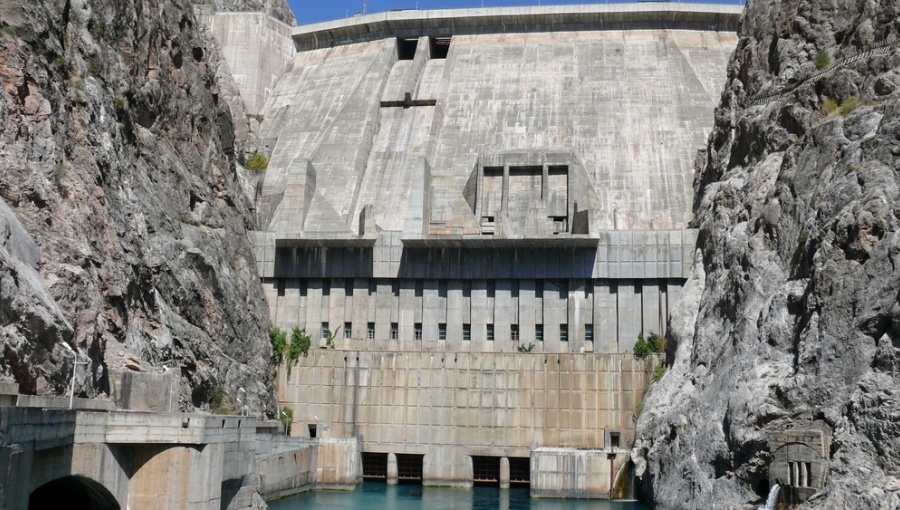Low reservoir water levels mean tough winter for hydro-dependent Kyrgyzstan

A harsh winter awaits Kyrgyzstan. That was Energy Minister Taalaibek Ibraev’s message to the country, as he recently revealed that the volume of water in Toktogul Reservoir, which feeds many of the country’s hydroelectric plants, is at its lowest level for this time of year in more than a decade.
“With every year, we’re feeling the water shortage more and more acutely, and this trend is observed around the world,” Ibraev said, adding that in mid-September, there were 10.8 cubic kilometres (10.8bn cubic metres) of water in the reservoir.
Toktogul feeds five major hydroelectric power plants (HPPs) that generate around 97% of the country’s hydroelectricity. That includes the Toktogul Hydropower Plant, which alone generates up to 40% of the country’s power. Over 90% of the country’s generation comes from hydro.
In 2008, the only time in recent memory that Toktogul’s September water level was lower than this year, it triggered an energy crisis. By September of that year, the reservoir had only refilled to 9.6 cubic kilometres of water. The ensuing power shortage plunged Bishkek into darkness up to 10 hours a day that autumn.
Ibraev gave an assurance that Kyrgyzstan will not experience a repeat of 2008. “Regulatory measures,” including the use of smart meters that will cut power to major users once they exceed their contracted amount of electricity, will help prevent prolonged blackouts, he said in an interview with local news agency 24KG. The country, which previously subsidised energy, is also raising bills by between 10% and 15% a year through 2030 to promote more efficient use of electricity.
The low water level will reduce power generation by 1.6bn kilowatt hours this winter, Ibraev said. To help offset that shortfall, the country has signed contracts with Uzbekistan, Kazakhstan and Turkmenistan to supply a little over 4.2bn kilowatt hours of power this winter, up from 3.8bn kilowatt hours last winter.
Speaking to 24KG, Ibraev attributed the drop in water level to lower-than-average precipitation this year.
Kyrgyz reservoirs accumulate water during the spring and summer mainly from snow and glacier melt, and the authorities then release water during the winter to generate power when it is needed most. The reservoir’s high water mark usually comes around early autumn when glacial melt stops and before power consumption rises.
The Toktogul Reservoir, Kyrgyzstan’s largest, can hold about 19.5 cubic kilometres of water, but below about 5.5 cubic kilometres, the hydroelectric cascade that depends on it cannot operate. Kyrgyzstan came close to crisis in spring 2024 when the water level almost crossed that threshold.
Toktogul’s September level has been on a downward trend in recent years. It filled to its maximum level last in 2017 before falling to 15.2 cubic kilometres in September 2020, 13.5 cubic kilometres in 2022 and 12.9 cubic kilometres in 2024, according to local media outlet Kaktus.
The link between climate change and runoff into Central Asia’s mountain rivers is complex. In the short-term, accelerated glacial melt and more precipitation may increase or maintain the flow of rivers like the Naryn, on which the Toktogul Reservoir is located. But the science is mixed. Global warming could also accentuate climate extremes in the Tian Shan mountains and bring more boon years like 2017 and more lean years like this one.
Kyrgyzstan is working to increase its generation capacity. Seventeen or 18 small hydroelectric stations will come online this year, and repairs are under way at Bishkek’s coal-fired coal plant. Last week, the governments of Kyrgyzstan, Uzbekistan and Kazakhstan said they would accelerate work on the Kambarata-1 hydroelectric station upstream from Toktogul, which, when completed, could generate more than 5.5bn kilowatt hours.
Ibraev claimed Kyrgyzstan may “get out of this crisis by 2028,” but urged people to save energy this winter. “We save energy. Our little grandson has learned this too. When he leaves a room, he turns off the light. He’s quite used to it,” Ibraev said.
Alexander Thompson is a journalist based in Bishkek, Kyrgyzstan, reporting on current events across Central Asia. He previously worked for American newspapers, including the Charleston, S.C., Post and Courier and The Boston Globe.
This article first appeared on Eurasianet here.



Follow us online